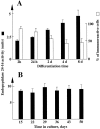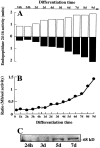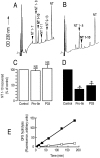Distinct properties of neuronal and astrocytic endopeptidase 3.4.24.16: a study on differentiation, subcellular distribution, and secretion processes
- PMID: 8756435
- PMCID: PMC6579318
- DOI: 10.1523/JNEUROSCI.16-16-05049.1996
Distinct properties of neuronal and astrocytic endopeptidase 3.4.24.16: a study on differentiation, subcellular distribution, and secretion processes
Abstract
Endopeptidase 3.4.24.16 belongs to the zinc-containing metalloprotease family and likely participates in the physiological inactivation of neurotensin. The peptidase displays distinct features in pure primary cultured neurons and astrocytes. Neuronal maturation leads to a decrease in the proportion of endopeptidase 3.4.24.16-bearing neurons and to a concomitant increase in endopeptidase 3.4.24.16 activity and mRNA content. By contrast, there is no change with time in endopeptidase 3.4.24.16 activity or content in astrocytes. Primary cultured neurons exhibit both soluble and membrane-associated endopeptidase 3.4.24.16 activity. The latter behaves as an ectopeptidase on intact plated neurons and resists treatments with 0.2% digitonin and Na2CO3. Further evidence for an association of the enzyme with plasma membranes was provided by cryoprotection experiments and electron microscopic analysis. The membrane-associated form of endopeptidase 3.4.24.16 increased during neuronal differentiation and appears to be mainly responsible for the overall augmentation of endopeptidase 3.4.24.16 activity observed during neuronal maturation. Unlike neurons, astrocytes only contain soluble endopeptidase 3.4.24.16. Astrocytes secrete the enzyme through monensin, brefeldin A, and forskolin-independent mechanisms. This indicates that endopeptidase 3.4.24.16 is not released by classical regulated or constitutive secreting processes. However, secretion is blocked at 4 degrees C and by 8 bromo cAMP and is enhanced at 42 degrees C, two properties reminiscent of that of other secreted proteins lacking a classical signal peptide. By contrast, neurons appear unable to secrete endopeptidase 3.4.24.16.
Figures










Similar articles
-
Stably transfected human cells overexpressing rat brain endopeptidase 3.4.24.16: biochemical characterization of the activity and expression of soluble and membrane-associated counterparts.J Neurochem. 1997 Feb;68(2):837-45. doi: 10.1046/j.1471-4159.1997.68020837.x. J Neurochem. 1997. PMID: 9003076
-
Colocalization of neurotensin receptors and of the neurotensin-degrading enzyme endopeptidase 24-16 in primary cultures of neurons.J Neurosci. 1990 Dec;10(12):3916-21. doi: 10.1523/JNEUROSCI.10-12-03916.1990. J Neurosci. 1990. PMID: 2176676 Free PMC article.
-
Neurotensin and neuromedin N undergo distinct catabolic processes in murine astrocytes and primary cultured neurons.Eur J Biochem. 1994 Apr 1;221(1):297-306. doi: 10.1111/j.1432-1033.1994.tb18741.x. Eur J Biochem. 1994. PMID: 7909519
-
Expression of both constitutive and inducible nitric oxide synthases in neuronal and astrocyte cultures.Ann N Y Acad Sci. 1994 Nov 17;738:462-7. doi: 10.1111/j.1749-6632.1994.tb21838.x. Ann N Y Acad Sci. 1994. PMID: 7530426 Review. No abstract available.
-
DINE (damage induced neuronal endopeptidase).Protein Pept Lett. 2004 Oct;11(5):451-60. doi: 10.2174/0929866043406526. Protein Pept Lett. 2004. PMID: 15544566 Review.
Cited by
-
The alpha-secretase-derived N-terminal product of cellular prion, N1, displays neuroprotective function in vitro and in vivo.J Biol Chem. 2009 Dec 18;284(51):35973-86. doi: 10.1074/jbc.M109.051086. J Biol Chem. 2009. PMID: 19850936 Free PMC article.
-
Structure of neurolysin reveals a deep channel that limits substrate access.Proc Natl Acad Sci U S A. 2001 Mar 13;98(6):3127-32. doi: 10.1073/pnas.051633198. Epub 2001 Mar 6. Proc Natl Acad Sci U S A. 2001. PMID: 11248043 Free PMC article.
-
α-Secretase-derived fragment of cellular prion, N1, protects against monomeric and oligomeric amyloid β (Aβ)-associated cell death.J Biol Chem. 2012 Feb 10;287(7):5021-32. doi: 10.1074/jbc.M111.323626. Epub 2011 Dec 19. J Biol Chem. 2012. PMID: 22184125 Free PMC article.
-
Mapping sequence differences between thimet oligopeptidase and neurolysin implicates key residues in substrate recognition.Protein Sci. 2002 Sep;11(9):2237-46. doi: 10.1110/ps.0216302. Protein Sci. 2002. PMID: 12192079 Free PMC article.
-
p53-Dependent transcriptional control of cellular prion by presenilins.J Neurosci. 2009 May 20;29(20):6752-60. doi: 10.1523/JNEUROSCI.0789-09.2009. J Neurosci. 2009. PMID: 19458243 Free PMC article.
References
-
- Barelli H, Vincent JP, Checler F. Peripheral inactivation of neurotensin: isolation and characterization of a metallopeptidase from rat ileum. Eur J Biochem. 1988;175:481–489. - PubMed
-
- Barelli H, Vincent JP, Checler F. Rat kidney endopeptidase 24.16: purification, physico-chemical characteristics and specificity towards opiates, tachykinins and neurotensin-related peptides. Eur J Biochem. 1993;211:79–90. - PubMed
Publication types
MeSH terms
Substances
LinkOut - more resources
Full Text Sources
Other Literature Sources
